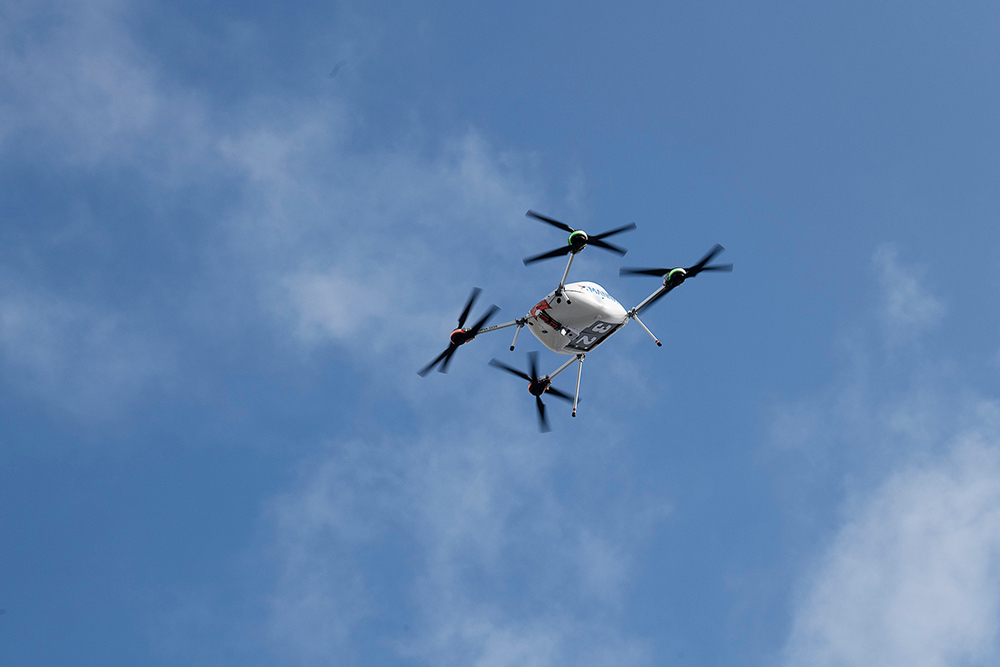Advanced drone to be deployed to monitor radiation at uranium sites in Central Asia
The new technology will make monitoring radiation at the sites, an integral part of environmental remediation, easier and safer.

An emerging technology combining a drone with a highly sensitive gamma-ray detector will be deployed in the coming months to monitor radiation at contaminated uranium legacy sites in Central Asia. These sites are former uranium mining and processing areas in Kazakhstan, Kyrgyzstan, Tajikistan and Uzbekistan and this advanced drone technology will support the safe and secure monitoring of radiation levels at these sites.
“Uranium mining and processing in this region between the 1940s and 1990s has left behind a number of radioactively contaminated uranium legacy sites,” said Sven Altfelder, an IAEA remediation safety specialist, adding that ‘experts in Central Asia monitor these sites for radioactivity on foot, wearing backpacks equipped with gamma-ray spectrometers that detect the presence of natural radionuclides, including uranium.” As most of the uranium legacy sites lie in difficult-to-reach mountainous and seismically active areas, monitoring with backpacks is challenging and less efficient, he said.
This challenge was recognized by the IAEA’s Coordination Group for Uranium Legacy Sites (CGULS), which in 2017 partnered with a consortium of experts from Germany, Kazakhstan, Kyrgyzstan, Tajikistan and Uzbekistan to implement a research project funded by the German Ministry of Education and Research (BMBF) that collaborated to develop the drone that is currently in the final testing phase.
The new technology will make monitoring radiation at the sites, an integral part of environmental remediation, easier and safer. “The tailor-made UAV-based gamma spectrometer will make it possible for experts to explore sites without the need to trek through difficult terrain with lots of gear,” said Altfelder. “By using the UAV to conduct monitoring duties, experts in the region will be able to easily gather the necessary data quickly, while avoiding potential physical and radiological risks altogether.”
The initial phase of the project was completed in 2020 with the practical tests of the system in Ronneburg, Germany, where detailed contamination maps were obtained from the flights over partially remediated uranium legacy sites. Throughout this phase, the IAEA’s CGULS has facilitated the participation of Central Asian experts in practical workshops and coordination meetings and provided logistical assistance for the fieldwork. Practical training for Central Asian experts by the IAEA on the use of the system in the region is scheduled to take place later this year.
The UAV will carry a gamma spectrometer that’s been specially selected for its accuracy in detecting the presence and concentration of the radionuclides that may be present at the sites. It aligns well with the IAEA’s efforts to use advanced drone technology such as in Fukushima Prefecture in Japan to monitor radionuclides in contaminated areas in the vicinity of the damaged power plant that can be too dangerous for in-person monitoring.
Malte Ibs-von Seht, the project coordinator from the Institute for Geosciences and Natural Resources (BGR), Germany, said, “UAV-based gamma spectrometry is easier to use and has lower operational costs compared to well-established airborne methods such as helicopter-based gamma spectrometry. It also has a fast mapping speed.”
The introduction of the new system will also enhance communication with affected communities: “We will be able to use the results obtained by the UAV to explain remediation results to the local population and demonstrate that those areas are now safe,” said Azamat Mambetov, State Secretary of the Kyrgyzstan Ministry of Emergency Situations.
Framework for development
The international community has recognized the challenges associated with achieving safe, sustainable remediation of the ULS in Central Asia and requested action be taken by adopting a number of United Nations (UN) General Assembly resolutions. The 2013 UN resolution underpinned the initial drive for international solidarity while the 2018 resolution reiterates the commitment of the international community and directly references the Strategic Master Plan for Environmental Remediation of Uranium Legacy Sites in Central Asia as one of the key elements of sustainable remediation in the region.
In 2017, the Strategic Master Plan for Environmental Remediation of Uranium Legacy Sites in Central Asia, which focuses on Kyrgyzstan, Tajikistan and Uzbekistan, was adopted by the IAEA, the European Commission, the European Bank for Reconstruction and Development, the Commonwealth of Independent States Economic Council as well as the governments of Kyrgyzstan, Tajikistan and Uzbekistan — to establish a strategy and concrete mechanisms to remediate the sites safely and sustainably. Currently, remediation is underway at several sites in Kyrgyzstan, while preparatory work is ongoing in Tajikistan and Uzbekistan. The upcoming revised version of the Plan will focus on seven priority uranium legacy sites — Mailuu-Suu, Min-Kush and Shekaftar in Kyrgyzstan, Degmay and Istiklol in Tajikistan and Charkesar and Yangiabad in Uzbekistan — to advance remediation efforts and help bridge the remaining funding gap.
The CGULS has a key and critical role in promoting cooperation among the IAEA Member States affected by uranium legacy issues, and national and international organizations involved in the management, remediation or regulatory oversight of the uranium legacy sites. This effort is undertaken by providing a forum for the exchange of information and technical advice, as well as promoting a coordinated and comprehensive approach to environmental remediation.
- READ MORE ON:
- Central Asia
- Sven Altfelder
- IAEA
- technology
- uranium










